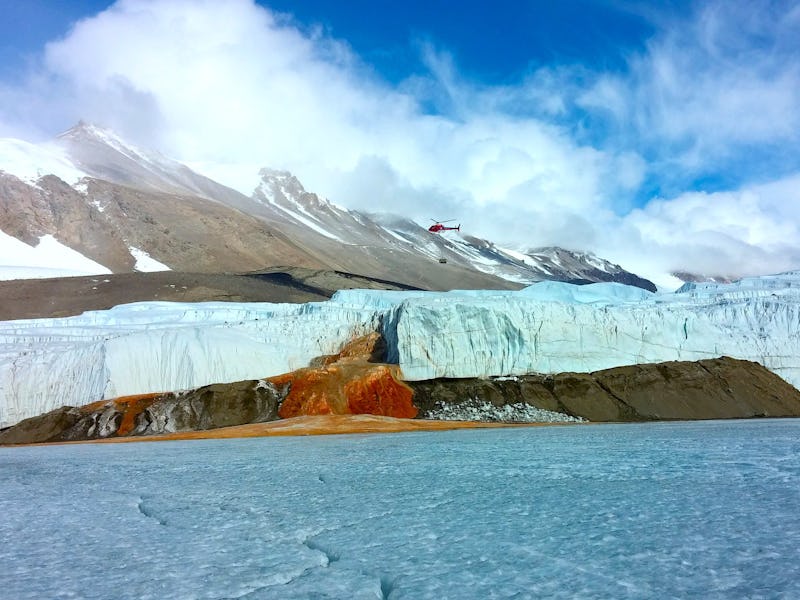8 Great Science Tourism Destinations to Visit While You Still Can
Learning is fun, especially when it requires a connecting flight.

It’s a question that plagues amateur science geeks everywhere: where to go on vacation? The water park is too crowded, and furthermore, teeming with the kind of aggressive microbial subcultures that make relaxation difficult.
No, you, armchair Einstein, need a place that stimulates your brain. Fortunately, Inverse has assembled seven destinations where you can actually learn something.
1. The Long Now 10,000 Year Clock
The Long Now is an organization founded to combat our culture’s burgeoning obsession with momentary, short term gains made at the expense of long-term planning. One method they use is referring to the current date with five digits, as in 02015.
To drive home their point, Long-Nowers, including musician Brian Eno and most of the founders of WIRED, operate two working prototypes of a 10,000 year clock at San Francisco’s Fort Mason. The clock does more than just keep time. Inventors and developers prioritized using sustainable materials that were also not, to our current evaluation, expensive, in the event that an apocalypse occurs and scrapping for rare metals becomes a stock-in-trade. Yeah, they’re thinking pretty far ahead, and in fascinating ways.
2. The Solar System in Black Rock, Nevada
Two filmmakers, Wylie Overstreet and Alex Gorosh, recently built a to-scale model of the solar system to impress upon viewers the immensity of the Solar System. It’s likely a good deal more imaginative than the styrofoam sculpture you threw together in third grade.
3. Hobby-Eberly Telescope
While Earth-bound telescopes have their limitations, the largest and most accessible is the Hobby-Eberly Telescope. Located at the McDonald Observatory in West Texas and managed through a joint effort by the University of Texas and Penn State, the HET, designed to use spectroscopy to study distances between stars, planets, and galaxies, offers some of the clearest and strongest views of outer space available to Earth-bound eyes.
Scientists have also been able to use the HET to measure the radius of supermassive black holes and observe the rotation of far-off galaxies.
4. Large Hadron Collider
The Large Hadron Collidor is the biggest, fastest particle accelerator in existence. Credited with bringing mankind one step closer to proving theoretical physics principles like the existence of the God particle, the Hadron Collider is located deep under the CERN research center in Geneva, Switzerland.
While you can get no closer than a surface tour of the CERN facility, that’s still something. And don’t worry: rumors that the Collider could create an Earth-destroying black hole while you’re visiting have been greatly exaggerated.
5. The Tesla Science Center at Wardenclyffe
Though most of Tesla’s laboratories have been destroyed or repurposed, an indieGoGo campaign launched to save Tesla’s last laboratory in Shoreham, New York recently reached its goal.
However, more money will be needed to clean and renovate the area, which was ruined by chemicals from a photo processing company that used the laboratory after Tesla’s death. When it’s done, you can see where one of the sacred cows of 21st century performed his last experiments.
6. Blood Falls
Providing a bit of Kubrickian color to the mostly white Antarctic landscape, Blood Falls is a waterfall of brine mixed with iron that bubbles up to and over the surface of Taylor Glacier.
Of special intrigue to biologists, Blood Falls is the only known surface manifestation of a deep brine ecosystem, loaded with microbial cells. It is a beautiful, if unnerving, phenomena and a landscape feature with an expiration date.
7. Dry Valleys, Antarctica
While you’re in Antarctica — presumably finishing your contract with Raytheon — you might as well check out Dry Valleys. With an average yearly snowfall of 0 mm — that’s right, nothing. Dry Valleys is considered the driest place on Earth.
The snow-free plateau is home to the McMurdo Dry Valleys Long Term Ecological Research Center, where scientists are using the arid conditions to research what life will be like on Mars.
8. SpaceX Research Facility
Currently, the hottest company in a competitive and intense market, SpaceX operates a research facility in Hawthorne, CA and welcomes tourists who know someone (or someone who knows someone). The tour, which is very well-reviewed on Yelp, is not the sort of factory tour that requires a simple ticket. Slight more Wonka-esque, something sleuthing and networking is necessary to get behind these scenes. That said, it’s worth it even if it takes a while. For what it’s worth, the coffee in the lobby is excellent.